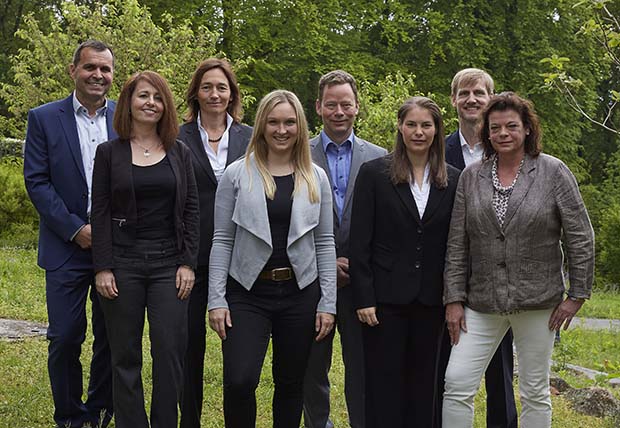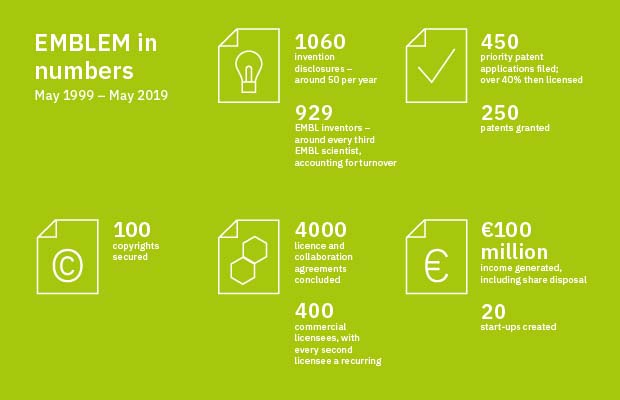by Cella Carr

Reflecting on the past and looking to the future of technology transfer at EMBL
“Ultimately, what drives us is to make an impact on human health and to secure the best interests of EMBL,” says Gábor Lamm, reflecting on the 20th anniversary of EMBLEM, EMBL’s technology transfer partner. EMBLEM was established in May 1999, and Gábor has been at the helm as Managing Director almost since its inception.
Technology transfer is the bridge that takes innovative science from the lab and sees it through the process of development into commercial products – novel drugs, therapies, diagnostics and medical devices – that can be used for the benefit of society. It is one of EMBL’s key missions.
The decision to establish a company to handle technology transfer at EMBL was made in 1998. One of the reasons for this decision is that commercial activity would jeopardise EMBL’s special status as an intergovernmental research organisation. EMBLEM was therefore set up as a company that operates according to German rather than international law, and which pays corporate tax in Germany. It is thus free to pursue commercial interests and to make decisions independently of EMBL.
A close eye on science
That’s not to say that there isn’t a close relationship between EMBLEM and EMBL. On the contrary, Gábor and his team are proactive in identifying potential commercial opportunities. “We’re at EMBL all the time,” Gábor says. “The Faculty Seminars, where the different groups talk about their research, are very important for us, as are the faculty retreats. We interact with – and take good ideas from – people at all levels, from PhD students to senior scientists.”
Training scientists is also an important part of EMBLEM’s work. All new PhD students receive training on various aspects of technology transfer, including patenting, public disclosure, and the various types of open-source licences.
Securing EMBL’s commercial interests
EMBLEM’s technology transfer remit spans a broad spectrum of activities. These include identifying and protecting intellectual property, facilitating the establishment of spin-off companies from EMBL, licensing technologies to third parties, marketing and contracting scientific consultancy services, and developing collaborative research agreements.
Collaborations are extremely valuable for EMBL scientists. “In the late 2000s we realised that just doing licence agreements was not enough,” says Gábor. “With collaboration agreements, an industrial partner brings something to the table that’s valuable for EMBL scientists, and the scientists contribute something that the industrial partner doesn’t have. We have a joint collaboration on a focused project. It’s a mutually beneficial arrangement.”
Two key questions
Every innovation is unique and presents its own distinct challenges. However, in all cases the team at EMBLEM ask two key questions at the outset. First, what is the fastest way to ensure that this technology is deployed in the market? And, second, what is the best way to ensure that this technology is made available as broadly as possible to benefit society?
“The answers to both of those questions define everything else that we do,” explains Gábor. “They define the intellectual property protection and commercialisation strategy: is the innovation going to be protected by a patent or by other means? If a patent, in which territories and with what scope? Is it going to be a single patent family, or do you build a patent portfolio around this topic? Who are the potential licensees? Will you put it into a start-up, or license it to an established company? Are you going to have multiple and exclusive licences? All of these decisions follow on from the answers to those two simple questions.”
EMBLEM helps us with technology transfer, licensing and contracts. We’re very lucky to have EMBLEM as part of EMBL, and it’s just a pleasure working with our EMBLEM colleagues.
EMBL Ventures and the EMBL Technology Fund
From the start, Gábor was convinced of the importance of having a venture capital vehicle associated with EMBL. The EMBL Technology Fund, managed by EMBL Ventures, was established to invest in life science start-ups emerging from EMBL and, importantly, from its member states. The first EMBL Technology Fund was raised in 2002. It amounted to €26 million, which was invested in 13 portfolio companies. Three of these originated at EMBL. The second fund, amounting to €40 million, was raised in 2011. It was invested in 11 portfolio companies, one of which was Luxendo (see below).
In 2006, the EMBL Technology Development Fund was created. This is a classic ‘proof-of-concept fund’ to develop early inventions to a stage of commercial potential. The initial investment was about €1.7 million, which funded 11 proposals and resulted in four spin-off companies. These have already returned around €8 million to EMBL, attracted €24 million of additional external investment, and seen the creation of over 50 new jobs. By any measure, that is a good return on investment.
Milestones on the road to success
EMBLEM is now among the top five technology transfer entities for the life sciences in continental Europe. In 2004, EMBLEM recouped all of EMBL’s previous investments in technology transfer, and since then the company has returned an annual surplus to EMBL, amounting to over €40 million over the past 20 years. This money is earmarked for further collaborations between science and industry, across EMBL groups and sites. “To put this in context, it usually takes at least 10 years for a tech transfer company to break even,” says Gábor. “And many never make a cent.”
The company passed another significant milestone in 2018, when it generated in excess of €10 million from licensing, collaboration, service and consultancy contracts. “The monetary part of what we do is important, but by no means is it the main criterion when we make decisions,” says Gábor. “If you only have the money in sight, you’re going to lose the big picture. Our focus has always been the mid- and long-term sustainability of the activity, and to return value to EMBL and to society.”
The success of any company depends on the people behind it. At EMBLEM, a small team of highly trained scientists – many with postdoctoral research experience; most having also worked in industry – are driven by a passion for science and a desire to make a positive impact. “We are innovators, bridge-builders and service providers,” says Gábor. “We don’t sit around and wait for things to happen.”
“EMBLEM is committed to bringing together researchers from academia and industry. My research has benefited from a decade of their excellent support, and I look forward to working with them in the future.”
Looking to the future
EMBLEM’s many successes over the past 20 years are cause for pride and celebration, but there is no room for complacency. Gábor Lamm is looking to the future. “We want to maintain a high level of service for EMBL, and to expand our business offerings. We’d also like to develop new initiatives to foster innovation, and to develop commercially viable opportunities. We want to help deepen EMBL’s relationships with industry, and to support the institute in achieving its goals.” With quiet confidence he concludes, “We’re good at what we do.” This is surely an understatement, but the results speak for themselves, without any need for embellishment.

Spotlight on Luxendo
“It was obvious that this technology was a breakthrough,” says EMBL group leader Lars Hufnagel, of the light-sheet microscopes developed in his lab at EMBL. The MuVi SPIM (multi-view single-plane illumination microscope) and InVi SPIM (inverted view SPIM), developed in collaboration with EMBL group leader Jan Ellenberg, sparked intense interest in the scientific community. Inundated with requests from scientists who wanted to come to EMBL to use the technology, or acquire it themselves, Hufnagel realised he needed to get the technology into the market. Fast.
Hufnagel and Ellenberg were building on the work of Ernst Stelzer, the former EMBL group leader who developed the first generation of SPIM microscopes at EMBL, and filed the first patent on the technology in 2002. “What was missing in the early prototypes was usability by biologists,” says Jürgen Bauer, EMBLEM’s Deputy Managing Director. “When Lars brought the technology to the next level of development, and generated instruments that were more robust and usable – closer to a product – we agreed that this would be a perfect basis to turn this into a spin-off company.”
Mutual benefits
The resulting company – Luxendo – was created in September 2015 and venture capital funded by both the EMBL Technology Fund, managed by EMBL Ventures, and Life Sciences Partners, one of the largest life science venture investors in Europe, based in Amsterdam. Luxendo was acquired by the global scientific instrument manufacturer Bruker after only a year and a half. “Bruker recognised that we had a good team, and they kept it and expanded it,” says Hufnagel. Luxendo continues to be hosted on the EMBL campus in Heidelberg. “Initially there was a lot of knowledge from my lab going into this company,” says Hufnagel. “But now Luxendo finds better solutions, builds better components, which we integrate. That knowledge now flows back to EMBL.”
The Luxendo story exemplifies the unique ecosystem at EMBL
“This is a great example of excellent science coming together with perfect engineering competence to build a solution for scientists to answer biological questions,” says Bauer. “The Luxendo story exemplifies the unique ecosystem at EMBL which, together with EMBLEM and EMBL Ventures, allows innovations to be fast-tracked to prototype stage and then spun out into a start-up, which makes EMBL technology rapidly available to the scientific community and commercial partners.”

Open Targets: a paradigm for collaboration
“This is collaboration at its best,” Birgit Kerber, Business Development Manager at EMBLEM, says of Open Targets. “It’s a role model for large public–private partnerships and exemplifies how EMBL and EMBLEM together are successfully interacting with industry.”
Open Targets was established in 2014 and is based at the Wellcome Genome Campus in Cambridge, UK. It brings together partners from academia and industry to develop innovative approaches to drug target identification and prioritisation, using human genetics, genomics and other omics data. There are currently five pharma and two academic partners, one of which is EMBL’s European Bioinformatics Institute (EMBL-EBI), whose world-leading competencies are essential to Open Targets.
“There’s nothing going on in the life sciences, either in the research space or the development space, that is not impacted by bioinformatics,” says EMBL-EBI Director Rolf Apweiler, “and we have the expertise in large-scale data analysis and provision of these services to the scientific community.”
Shoulder to shoulder
EMBLEM is responsible for the business development side of Open Targets, and Kerber plays a lead role in getting new industry partners involved. “Open Targets works extremely well. It has established a portfolio of more than 50 interlinked projects and has published more than 20 articles across three therapeutic areas: oncology, immunology and neurodegenerative disease,” she says. “Scientists from academia and industry are working shoulder to shoulder on these projects. It’s a very intense collaboration, and that’s why it’s so successful. We’re operating in what’s called the pre-competitive space, where there’s room to share information, and that is beneficial to everybody.”
It’s a very intense collaboration, and that’s why it’s so successful
Open Targets hit the headlines earlier this year, with the announcement that researchers had identified thousands of genes that are key to cancer survival. The unique collaborative framework of Open Targets generates important results like these, and helps to facilitate and accelerate their translation into the development of new, safe and efficacious drugs.
Kerber is focused on the future. “Expanding the breadth of Open Targets, and having more Open Targets-like initiatives in other spaces – that’s a good prospect,” she says. “It’s a visionary initiative.”

This post was originally published on EMBL News
